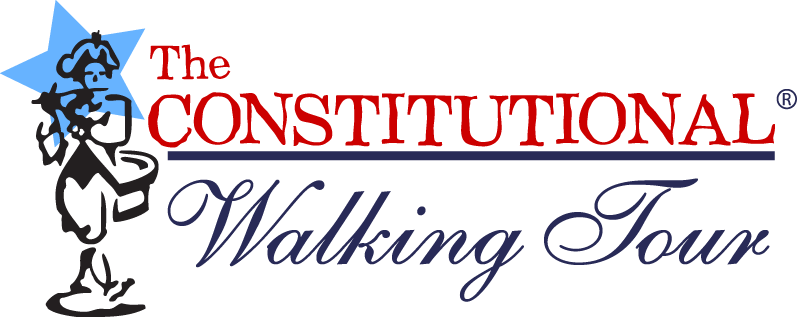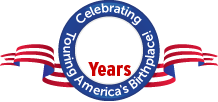Related Posts:
- Buy Tickets for The Constitutional Walking Tour of Philadelphia – See 20+ Sites on a Primary Overview of Independence Park, including the Liberty Bell and Independence Hall
- The Underground Railroad in Philadelphia
- The President's House
- Independence Hall History
- Liberty Bell Visitor Guide
- African American Museum in Philadelphia
- Timeline - Road to Nationhood
- George Washington - One of America's Founding Fathers
- John Adams - One of America's Founding Fathers
Overview
Within steps of the Liberty Bell and Independence Hall where America was born sits the former site of the President’s House where President George Washington and President John Adams lived when they served in office, while Philadelphia was the Capital City of the United States from 1790-1800.

The site is entitled, “President's House: Freedom and Slavery in the Making of a New Nation”, and there are great exhibits which provide an overview of slavery in the Americas, including in Philadelphia. The location of this prominent slavery memorial at the President’s House came about through conflict and compromise between the National Park Service and vocal leaders in the community as detailed below.
It should not be lost that this slavery memorial is one block from where Thomas Jefferson wrote The Declaration of Independence in 1776 at the Declaration House at 7th & Market Streets which boldly stated, “We hold these truths to be self-evident, that all men are created equal, that they are endowed by their Creator with certain unalienable Rights, that among these are Life, Liberty and the pursuit of Happiness.”
It should not be lost that slavery existed in the shadow of Independence Hall where America was born and the Constitution of the United States was drafted, debated and signed in 1787.
It should not be lost that this slavery memorial exists in the shadow of Congress Hall at 6th & Market Streets where on December 15, 1791, the first Ten Amendments to the Constitution of the United States were ratified. These Ten Amendments, which we call the “Bill of Rights” is a very important document, which today guarantees all Americans many personal freedoms and limits the power of the United States government. For example, the Bill of Rights included the freedom of speech, freedom of the press, freedom of religion, etc.
The purpose of the slavery memorial is so that we never forget this sad chapter in American history with slavery and to pay tribute to the nine African descendants who were slaves owned by President George Washington at the President’s House: Austin, Christopher Sheels, Giles, Hercules, Joe (Richardson), Moll, Ona/Oney Judge, Paris, and Richmond.
In contrast to President Washington, President John Adams was an abolitionist, and he did not own any slaves.

Slavery in the Americas
The Trans-Atlantic slave trade began in the early 1500s with the arrival of Dutch and Portuguese explorers, and the Trans-Atlantic slave trade did not end until Brazil stopped importations in 1867.
“Chattel Slavery” -- the legal ownership of men, women and children by others who could sell them at will -- existed throughout the Americas.
Roughly 12.5 million Africans, principally from West and Central Africa, were purchased from African traders by European and American traders and brought to the Americas. After independence, many Americans, especially Northerners, continued to be involved in slave-trading by outfitting and manning slave-trading ships.
Britain outlawed the slave trade in 1808, and that year, by the terms of the United States Constitution, Congress made it illegal to import enslaved persons. However, the buying, selling and ownership of enslaved persons continued within the United States.
After 1808, the population of enslaved people in the United States continued to grow primarily by natural increase, including births to enslaved women resulting from rape by white men and forced breeding. Also, there were relatively low death rates due to a decline in disease, favorable climate, and adequate food supply.

Slave Economy - Slavery in the North and South
In the 1630s, when this region was part of the New Netherlands, the Dutch brought enslaved Africans to the area now known as Pennsylvania. English, Scots-Irish, and German settlers, including many Quakers, expanded slavery once they began moving to the new Colony of Pennsylvania after 1681. By 1790, Africans and their descendants were concentrated in Maryland, Virginia, and Southern Delaware, and the Carolinas and Georgia, where plantations dominated the economy.
Wealth at a Terrible Price
Enslaved labor played a dominant and growing role in the nation’s economy as shipbuilding, trade with the West Indies, and the production of rice, indigo, and tobacco thrived. A developing global economy created increased demand for raw goods from West Indian plantations in exchange for rum, textiles and produce made or harvested in the United States. In the 1790s, Philadelphia was a major port for the provisioning trade that helped sustain slavery in the West Indies.

Slavery in a Growing Nation
Presidents Washington and Adams led a nation of almost four million people according to the first Federal Census in 1790, and the population grew to more than five million people by 1800. As Washington and Adams governed the new nation, slavery continued to grow. By 1800, one out of every six people in United States was enslaved.
| 1790 | 1800 | |
| Total U.S. Population | 3,929,214 | 5,308,483 |
| Free Africans | 59,150 (1.51%) | 108,500 (2.04%) |
| Enslaved Africans | 694,280 (17.67%) | 893,602 (16.83%) |
In the Ohio Territory, the Northwest Ordinance of 1787 made the Ohio River the boundary between the free and the slave territory, though decades more were needed to end slavery in the old Northwest completely. In the 1790s, Congress admitted Kentucky and Tennessee as slave states and Vermont as a free state.
Slavery in Philadelphia, Pennsylvania
Philadelphia’s enslaved before and after the Gradual Abolition Act of 1780.
| 1767 | 1775 | 1790 | 1800 | |
| Enslaved Africans | c. 1400 | c. 690 | 301 | 55 |
Slavery Timeline
1619 - Slaves were brought to Jamestown, Virginia.
1641 – Massachusetts legally recognized slavery.
1662 – Virginia law determined the status of all children born in this country to be the same as that of their mother.
1684 – The ship “Isabella” brought 150 enslaved Africans to Philadelphia.
1705 – Virginia law determined that all servants imported and brought into the country who were not Christians in their native country would be regarded as slaves. Slaves were “Chattel Property”, and could be disciplined or killed by their owners without penalty.
1775-1776 – The Pennsylvania Abolition Society was founded in Philadelphia, the first in the nation, and the Philadelphia Quaker Meeting banned slavery for its membership.
1780 – Pennsylvania passed the first Gradual Abolition Act in the United States. The Act prohibited the importation of enslaved Africans into Pennsylvania and guaranteed that future children of enslaved Pennsylvania mothers would be born free, but indentured until age 28. An enslaved resident born before the Act would not benefit from its provision and would remain in perpetual slavery unless freed by his or her owner.
1783 – Massachusetts abolished slavery.
1787 – The Northwest Ordinance banned slavery and involuntary servitude in the territory North of the Ohio River, but ambiguities and conflicts within its provisions allowed bondage to continue in the area for more than 50 years.
1788 – The Pennsylvania Legislature amended the 1780 Gradual Abolition Act. The amendment prohibited removal of a pregnant, enslaved woman out of state (so the child would be born enslaved), and the separation of enslaved family members by more than 10 miles. It also required registration of the child of an enslaved mother within six months of birth.
1793 – The Fugitive Slave Act, passed by the U.S. Congress, reinforced the Constitutional right of a slaveholder to recover a runaway slave. Anyone who harbored or concealed a fugitive could be fined $500.00. Anyone convicted of having interfered with the return of a fugitive slave to another state by using force could be fined not more than $500.00 and given a jail sentence of up to one year.
1804 – The Slave Trade Act, passed by the U.S. Congress, made it illegal for American ships to engage in the international slave trade and to sell enslaved people abroad.
1808 – The first children born after 1780 to enslaved Pennsylvania mothers were freed of their indentures under the 1780 Gradual Abolition Act.
1808 – The U.S. Congress banned international slave trade, but smuggling of slaves continued.
1820 – The Missouri Compromise established boundaries of slavery in the Louisiana Purchase Territory, closing the area North of the 36° 30’ latitude line to slavery.
1847 – The Pennsylvania Legislature freed all remaining enslaved people in the Commonwealth of Pennsylvania (fewer than 100 slaves). All of these slaves would have been 67 years of age or older.
1850 – The Compromise of 1850 included a strong new fugitive slave law that made it easier for slaveholders to retrieve escapees and overrode state’s rights to interfere with the recovery of slaves.
1851 – The largest trial of treason in U.S. history occurred in Philadelphia on the second floor of Independence Hall. Thirty-eight people, whites and people of African descent, stood trial for resisting the recovery of runaway enslaved persons near Christiana, Pennsylvania. One person was found not guilty, and charges against the rest were dismissed.
1857 – In the Dred Scott decision, the Supreme Court of the United States ruled that the U.S. Congress could not ban slavery in the territories, and that in the words of Chief Justice Taney, “a person of African descent in the United States has no rights that a white person or government must respect.”
1860 – The U.S. Federal Census counted almost four million enslaved people in the United States.
1863 – President Abraham Lincoln issued the Emancipation Proclamation.
1865 – The Thirteenth Amendment to the Constitution of the United States abolished slavery in the U.S. The Juneteenth Celebrations, held after the ratification of the 13th Amendment commemorated the date (June 19) on which the joyous news of the Emancipation Proclamation reached enslaved people in Texas.
1942 – Philadelphia Richard Robert Write, Sr., born into slavery in the South, organized the first National Freedom Day to commemorate the Thirteenth Amendment and call attention to continuing limitations on freedom. National Freedom Day is observed every February 1st at the Liberty Bell.
Constitutional Compromise
In 1787, the men who wrote the Constitution of the United States created a document based on the ideal of liberty, but liberty and enslavement were bitterly intertwined. The U.S. Constitution did not act against slavery. To appease slaveholders, the Constitution allowed the slave trade to continue until 1808. Furthermore, the Constitution required the return of escaped enslaved persons to their owners. Northern delegates also compromised on the issue of Congressional representation by allowing each enslaved person to be counted as 3/5 of an individual for population purposes.
Conflict and Collaboration
At first, the National Park Service minimized the importance of the President’s House site while it focused on the construction of the Liberty Bell Center. But, in the shadow of Independence Hall, another story, the one of slavery, had yet to be told. It was buried both literally and figuratively. Archeology at the President’s House site in 2006-007 exposed the basement level of where some of President George Washington’s servants carried out assigned duties in storerooms and cellar closets. At least nine of the servants were enslaved.

The National Park Service had agreed to a nominal interpretation for this site when the African American community, historians, scholars and concerned citizens insisted on an expanded vision. To that end, the President's House site has been transformed into a space honors the lives of those enslaved (whose stories have just begun to be told) framed by the history of the new nation from 1790-1800 when Philadelphia served as the Capital city of the United States.



